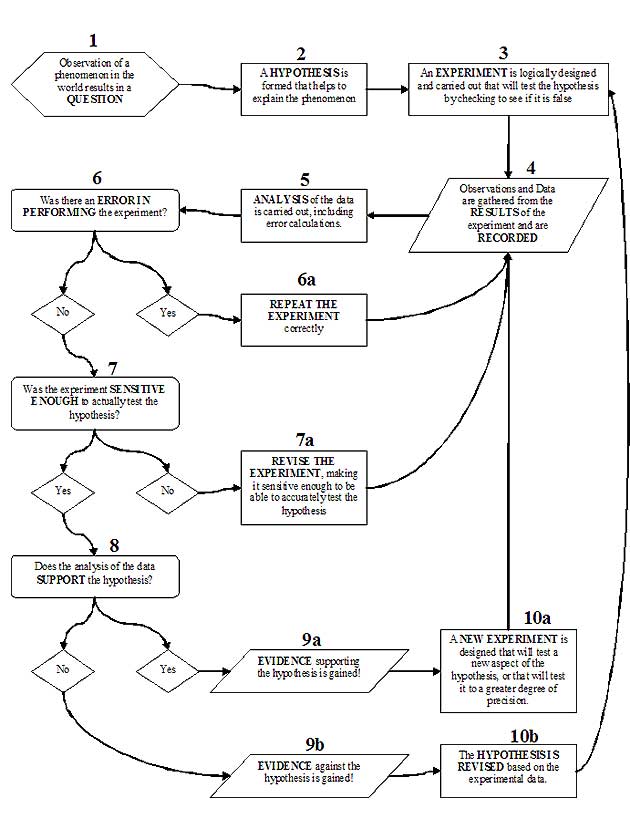Thermodynamics: The Physics of Heat
Mr. Miller
The Scientific Method: an Introduction
- What distinguishes a scientific theory from a non-scientific theory is that a scientific theory must be refutable in principle. A set of circumstances must potentially exist such that if observed it would logically prove the theory wrong.
- Here is a simplified version of the logic of the scientific method, see the flow chart on page 3 for more detail:
- We encounter a phenomenon with our senses, and a question arises out of our observations.
- Through a free, creative process, a hypothesis is generated that, if true, would at least partly explain why the particular phenomenon occurred to the exclusion of others.
- On the basis of this hypothesis, an experiment is logically deduced that, when carried out, will result in a set of particular observations that should occur, under particular conditions, if the hypothesis true. Data and observations are gathered from the result of the experiment and are recorded.
- If those particular expected observations do not occur, then we are faced with several possibilities: our hypothesis needs to be revised, or there was some source (or sources!) of error that interfered with the gathering or analysis of the data. If the particular observations do occur, then we gain some confidence in our hypothesis. The next step is then to form an alternate experiment that will test a new element of the hypothesis.
Summary of the Scientific Method:
- We have a question for the world
- We generate a hypothesis about it
- We test our hypothesis with an experiment
- We check our procedure and analysis for errors, and revise our hypothesis if necessary
- We continue the cycle with a new or revised experiment
The actual process often involves a great deal of insight and creativity. Keep in mind, though, that without a disconfirmation being possible in principle, a belief is not acceptable as even a potential scientific hypothesis. There must be a possible concrete test.
Summary
- A scientific theory must be testable. It must be possible in principle to prove it wrong.
- Experiments are the sole judge of scientific truth. (There are other kinds of truth!)
- Scientific method: observations, hypothesis/theory, experiment (test), revision of theory, new experiment
Advanced Notes on the Scientific Method (Use these to further your understanding of some of the details and complexities of science and the scientific method):
See: http://www.astronomynotes.com/scimethd/chindex.htm for more detailed information.
- The scientific method begins with a hypothesis, but as evidence for the hypothesis accumulates, the hypothesis becomes a model, and finally with widespread acceptance it becomes a full scientific theory.
- A correlation between two things does NOT prove one thing causes the other. The second thing could cause the first or some other underlying factor could cause the correlation.
- Scientists have to be very careful to rule out other possible underlying factors before concluding one thing causes something else.
- Though scientific proofs are not known with absolute certainty, enough evidence can be accumulated to be reasonably certain.
- No matter how much evidence we have for a conclusion, the conclusion could still conceivably be false.
- The more positive cases in favor of a hypothesis, the stronger the hypothesis is.
- The most logically sound samples are those that are representative of the entire set.
- It is possible to make true conclusions from false assumptions.
- A hypothesis can only be confirmed but it cannot be proven absolutely true.
- Even though a scientific hypothesis cannot be proven absolutely true, that does not mean that it must be false.
- Science is carried out through human effort and is therefore subject to all of the best and worst of cultural biases existing at the time.
- Though the assumption is not necessary for science, many scientists assume that science needs to consider only the physical, concrete objects around us.
- Some scientists assume that thought or consciousness is the most fundamental reality.
- Possible ways of knowing: testimony, authority, revelation, mystical visions, scientific method.
- Observational experience is a crucial part of scientific knowledge.
- No matter how much logical deduction and mathematical analysis is used, the scientific theory must be checked against the real world to confirm the theory.
- However, the exploration of the implications of a logical train of thought is a vital part of the scientific process.
- The best ideas are those that enable us to make connections between rational theories and our observations of the world.
The Scientific Method – the Basics